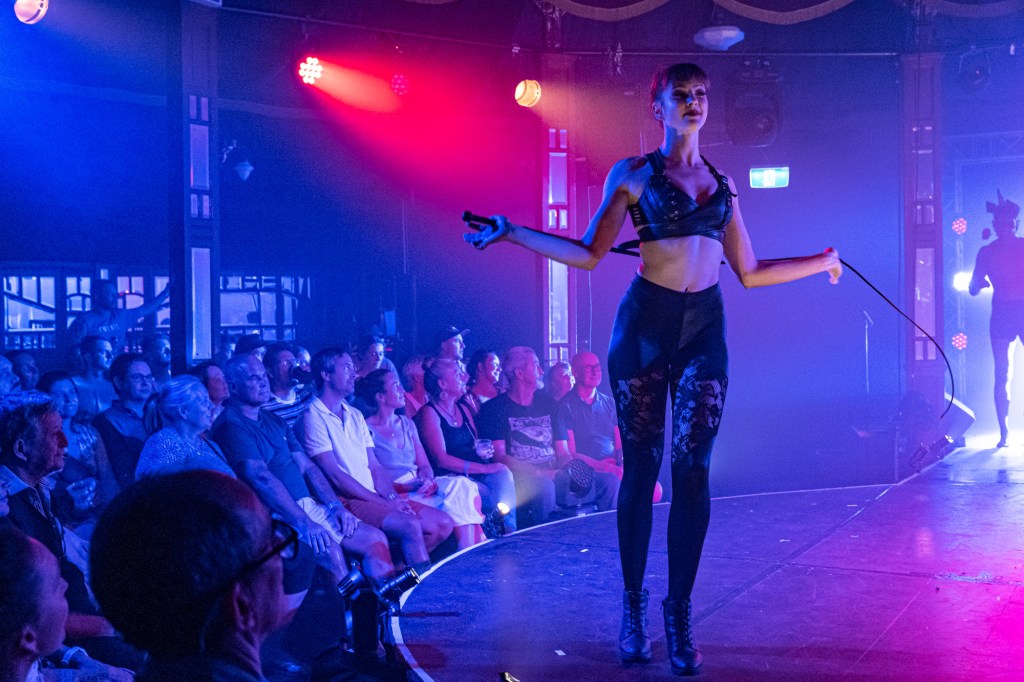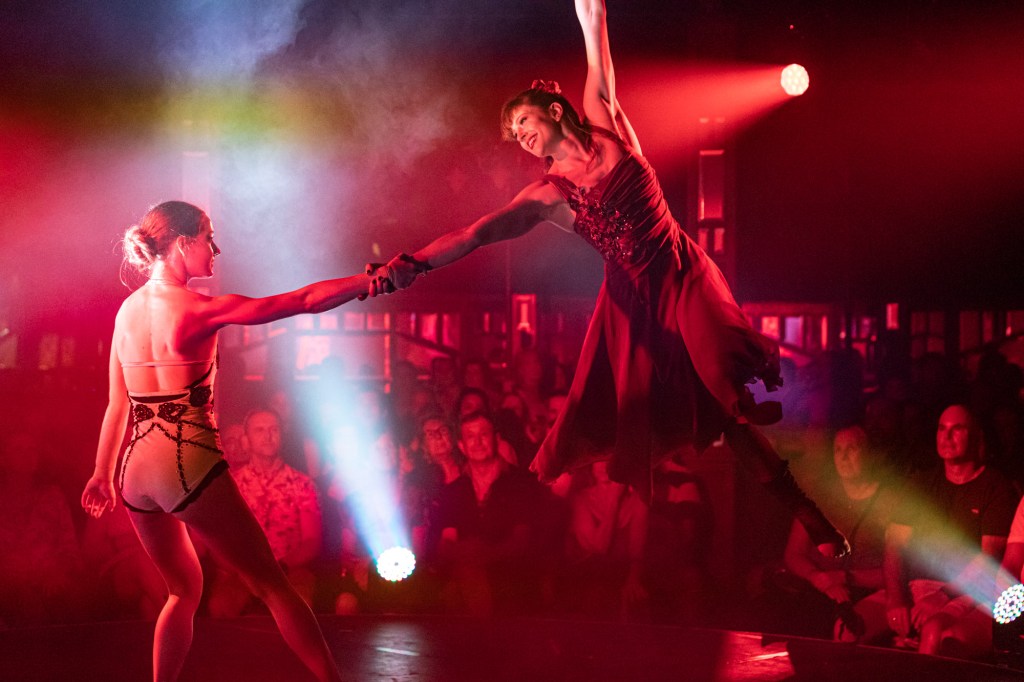In this article:
Picture this: you’re sitting in a circus tent at Edinburgh Festival Fringe immersed in a pre-show party scene – noughties tunes are pumping, the tent smells like Britney Spears’ perfume Fantasy, and the audience are dancing in their seats. Performers run through the crowd setting the vibe, party hats on and enthusiasm levels high. A woman in a skimpy sparkly dress brushes past audience members – greeting them, dancing a little … but things escalate and soon she’s grinding on audience members’ laps. Full of newfound energy, she kisses a male audience member on the lips – fake nightclub style. He looks… unsure. This is not OK, but it is very common.
Most live performance-makers and performers are are not spending enough time discussing – or asking for – audience consent.
One exception to this is Gluttony co-Director and Highwire Entertainment Director Elena Kirschbaum. Kirschbaum says, ‘We should be modelling consent in every part of our lives’ and I want to give her a standing ovation. She goes on, explaining that each time a new cast member joins Rouge, her very sexy adult circus cabaret show, the team have a conversation about consent. They discuss performing acts in the show and interacting with their fellow cast members, before using that as a bouncing off point to talk about consent with audience members.
There’s significant audience interaction in Rouge, and it’s of a sexy nature. To prepare for this, performers talk about ‘how to look for non-verbal cues throughout the show, so that you are regularly clocking the people who you think are going to be the ones that you would approach in that situation,’ says Kirschbaum.

She talks about Michaela Burger, an experienced (and exceptionally talented) performer, who sings while she interacts with audience members. Because she is singing, she can’t ask for verbal consent, and instead looks for clear and enthusiastic body language. Whereas performer Jessie Mckibbin, who gives a lap dance and gets an audience member to slap her on the butt, receives active verbal consent from participants.
Consent is not so clear in Bonnie He’s A Terrible Show for Terrible People – a mime show exploring sexual desire and the stereotyping of Asian women. During the show, He approaches audience members sexually, shaking her boobs and encouraging touching. My husband was approached to participate – He put her behind towards his face and mimed hitting, pointing “you”. After many uncomfortable shakes of his head, my husband gave in and slapped her, only to be shown he should repeat the action, harder. He did, but he didn’t want to. At the end of the show, He encouraged the audience to write reviews on the Edinburgh Fringe website, as a woman had written a review and was really mad about her shaking her boobs in someone’s face.
Progressive acts pushing personal boundaries
Interestingly, some of the performers not considering audience consent are seen as progressive and feminist acts. On stage, they make statements about embracing their sexuality, while causing some participating audience members to feel alienated and uncomfortable.
A Melbourne venue manager tells ArtsHub of one ‘woke, feminist’ show at her venue that made her uncomfortable. In it a performer asks an audience member to come on stage and they agree without knowing what’s to come. ‘They’ve said “yes”, but then the performer touches them and sits on their lap, I wonder where the line is. They agreed to participate, but don’t know what’s coming – some people might be keen for audience interaction, but don’t want to be touched.’
Consent isn’t just important for sexual advances. The worst audience participation I’ve witnessed was at comedy cabaret Amy Webber: No Previous Experience in an attic venue in Edinburgh. Performer Webber searched for a volunteer by saying, ‘This bit works best if we get someone up here who is really shy, so if you have someone next to you, and this would be their worst nightmare, point to them so I can choose someone.’ She then proceeded to select an audience member that had been unwillingly volunteered and made them dance, mime drying their sweaty crotch, and kiss her feet. During this participation, with which the “volunteer” coped rather well, she told the audience that a previous participant had nearly fainted on stage. Perhaps because they didn’t consent to being there?
Kirschbaum shares a performers’ secret about the perfect audience participant. ‘In an ideal world, you almost want somebody who’s going to be a little bit reluctant at first, but who actually really wants to be there.’ She says that it’s difficult to walk that line between somebody who’s not jumping out of their seat to be on stage, but who’s ultimately going to feel empowered about being there. She believes that this is not just about choosing the right person, but also about the routine/performance itself, and she has no patience for someone who creates a routine where the audience member is the butt of the joke. ‘It’s just punching down,’ she says.

The landscape for audience interaction has changed and personal space feels more important than ever post #MeToo and COVID. When I asked audience members for their stories of audience interaction, some of the examples dated back decades. While at first I brushed off these situations as too old or irrelevant because they may not happen now, they have since made me think what a big impact these brief moments have had, to keep people thinking about them many years later. I have been told of audience members worrying about the safety of themselves and others, of thinking “please don’t pick me, please don’t pick me”, and sitting towards the back to minimise the chance of these interactions. These stories are real, and emotional, but most importantly they could have been avoided.
Maybe performers think that consent will ruin the fun. Will audience members agree to participate if they need to consent? In short, yes. And in more detail, yes, there’s someone who’s up for anything in almost every audience. In Wonderfully Terrible Things at Adelaide Fringe 2024 an audience member enthusiastically agreed to drink wine that had travelled through a tube threaded through the performer’s nose. While writing this piece I was told of some even more intimate consensual audience interactions, but I will leave those to your imagination.
How do performers create audience interaction with consenting participants?
Ultimately, it’s about community. Ben Welch, Artistic Director of production company Sheep Soup, proves this in one of the most uplifting shows you’ll ever have the joy of participating in – House of Life. In this work, Welch sets the bar for audience consent, and enjoyment, sky high. He says, ‘Always it’s about creating a community. It’s about creating a vibe and also people feeling comfortable and safe.’ He wants the audience to know that they are going to be ‘validated and celebrated’ and not put down, and, golly, does he follow through.
Creating this safe place is key to friendly audience participation. This can be seen in Fringe Wives Club’s Glittery Clittery, self-described as a ‘consensual party’, and A Slightly Isolated Dog’s Don Juan. At the beginning of Don Juan, the performers greet the audience with open arms, as if each attendee is an old friend or a VIP. ‘Hello, darling! Thank you for coming, so glad you could be here.’ This sets the tone for its fun, well-guided audience participation.
When looking for genuine consent from participants there needs to be an opt-out, a real opportunity to say “no”.
Kirschbaum says, ‘I’ve been in a lot of audiences where I’ve been given pressure to say “yes” to things, to not let a performer down, and so I think it’s important that it’s not just getting a “yes” from someone if it’s really reluctant and they feel uncomfortable.’
Read: It’s not just acting: why consent matters in the performing arts
When I saw House of Life, Welch provided pressure-free opportunities for audience interaction. At one point he asked a young woman in front of me ‘what’s in your dream future?’ The woman looked uncomfortable; ‘uhmmm…’ she began. Welch noticed her hesitation and said, off-mic, ‘You don’t have to answer if you don’t want, you can just shake your head.’ But she did answer, comfortably and confidently, because that’s the effect that Welch had on her (and on all of us really). When she shared her dream of having ‘lots of animals’ we all cheered in celebration.
Welch talks about the importance of building trust as the involvement level is scaled up throughout a show. ‘You start with asking a name and asking for something that’s really low stakes,’ he says. ‘I think keeping everything really low stakes is important and, by the end, they’re on the stage having a sax solo and jumping around and dancing and joining in.’ Welch creates such a strong community within his audience that people not only stay for a drink after the show, but join fellow audience members (former strangers) for the night, going for dinner and seeing other shows together.
Can performers improve their audience skills?
Both Welch and Kirschbaum agree that getting audience consent, and making audience members feel comfortable, is a skill that can be improved. Welch reveals that many of his skills have come from years of facilitating workshops and working with vulnerable people. This work has allowed him to understand groups of people and spot boundaries. Some performers have built up this incredible ability, but anyone can ask: ‘Are you happy to answer this question/hold this balloon/slap my butt? You don’t have to.’
I want to be very clear that I don’t think performers in these negative examples are bad people, or even bad performers. Nor do I think the performers in these positive examples have never made a mistake. Audience consent is a new, but very important, conversation and I want to allow performers the space to grow and change. Kirschbaum sums it up brilliantly: ‘We’re not having conversations about how to make people feel safe and comfortable in our stages, whether that’s performers interacting with each other on a stage, or whether that’s performers who are interacting with their audience members. So it’s a great conversation to start having, because I think a lot of people have never even considered it.’





